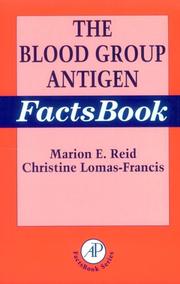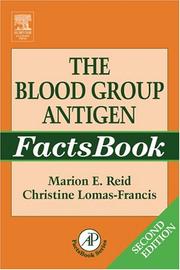| Listing 1 - 10 of 10 |
Sort by
|
Book
ISBN: 1839699035 Year: 2022 Publisher: London : IntechOpen,
Abstract | Keywords | Export | Availability | Bookmark
 Loading...
Loading...Choose an application
- Reference Manager
- EndNote
- RefWorks (Direct export to RefWorks)
Every cell in our body including red blood cells is covered with special markers called antigens, a substance that triggers the immune system response. Millions of antigens are present on the membrane of red blood cells and are ignored by the immune system because they are self-antigens. However, if a person receives a transfusion of blood that contains different antigens from their own blood, there will be a severe and immediate attack by the cells of the immune system. Therefore, it is important to use the patient's same blood group for the transfusion. The blood group antigens not only perform a critical role in the function of cells but can also be used by viruses to gain access into the cells. This book includes nine chapters on different blood group antigens and their activities behind the scenes. Chapters address blood antigens and their association with cardiovascular diseases, thromboembolic diseases, malaria, and many other diseases and infections.

ISBN: 0125859651 9780125859653 Year: 1997 Publisher: San Diego Academic Press
Abstract | Keywords | Export | Availability | Bookmark
 Loading...
Loading...Choose an application
- Reference Manager
- EndNote
- RefWorks (Direct export to RefWorks)
Blood group antigens --- Antigens --- Blood Group Antigens --- Antigen --- Erythrocytes --- Isoantigens --- immunology --- ANTIGENS --- BLOOD GROUPS --- HANDBOOKS --- IMMUNOLOGY
Book
Abstract | Keywords | Export | Availability | Bookmark
 Loading...
Loading...Choose an application
- Reference Manager
- EndNote
- RefWorks (Direct export to RefWorks)
MOLECULAR CLONING --- DNA --- HLA-D ANTIGENS --- HLA-DR ANTIGENS --- ISOANTIGENS --- KIDNEY TRANSPLANTATION --- LYMPHOCYTES --- T-LYMPHOCYTES --- GENETICS --- IMMUNOLOGY --- MOLECULAR CLONING --- DNA --- HLA-D ANTIGENS --- HLA-DR ANTIGENS --- ISOANTIGENS --- KIDNEY TRANSPLANTATION --- LYMPHOCYTES --- T-LYMPHOCYTES --- GENETICS --- IMMUNOLOGY

ISBN: 0125450257 9786611046811 1281046817 0080542506 9780125450256 9781435605152 1435605152 Year: 2000 Publisher: San Diego Academic Press
Abstract | Keywords | Export | Availability | Bookmark
 Loading...
Loading...Choose an application
- Reference Manager
- EndNote
- RefWorks (Direct export to RefWorks)
The HLA FactsBook presents up-to-date and comprehensive information on the HLA genes in a manner that is accessible to both beginner and expert alike. The focus of the book is on the polymorphic HLA genes (HLA-A, B, C, DP, DQ, and DR) that are typed for in clinical HLA laboratories. Each gene has a dedicated section in which individual entries describe the structure, functions, and population distribution of groups of related allotypes. Fourteen introductory chapters provide a beginner's guide to the basic structure, function, and genetics of the HLA genes, as well as to the nomenclatur
HLA histocompatibility antigens --- Histocompatibility antigens. --- Isoantigens --- HL-A histocompatibility antigens --- HLA antigens --- HLA transplantation antigens --- Human leukocyte antigens --- Transplantation antigens, Human --- Histocompatibility antigens --- Major histocompatibility complex

ISBN: 9780125865852 0125865856 9786611008338 0080476155 1281008338 1423742494 9781423742494 Year: 2004 Publisher: Amsterdam Boston Elsevier/Academic Press
Abstract | Keywords | Export | Availability | Bookmark
 Loading...
Loading...Choose an application
- Reference Manager
- EndNote
- RefWorks (Direct export to RefWorks)
The second edition of The Blood Group Antigen FactsBook provides key information relating to human red blood cell membrane components carrying blood group antigens, the molecular basis of the antigens, their serological characteristics, and the clinical significance of blood group antibodies. The data on this group of molecules has expanded greatly since the previous edition was published five years ago. Topics include: history and information on terminology, expression, chromosomal assignment, carrier molecule description, molecular basis of antigens, effect of enzymes/chemicals, clini
Blood group antigens --- Blood groups --- Blood --- Blood types --- Groups, Blood --- Types, Blood --- Heredity --- Physical anthropology --- Paternity testing --- Erythrocytes --- Isoantigens --- Groups --- Examination --- Agglutination --- Transfusion
Book
ISBN: 0387187650 Year: 1988 Publisher: New York, NY : Springer-Verlag,
Abstract | Keywords | Export | Availability | Bookmark
 Loading...
Loading...Choose an application
- Reference Manager
- EndNote
- RefWorks (Direct export to RefWorks)
GENETICS, POPULATION --- ANTIBODIES, MONOCLONAL --- BLOOD CHEMICAL ANALYSIS --- DNA --- ELECTROPHORESIS --- ISOANTIGENS --- STAINS AND STAINING --- CONGRESSES --- DIAGNOSTIC USE --- STATISTICS AND NUMERICAL DATA --- METABOLISM --- Genetics, Population
Book
ISBN: 0240821300 0124158498 9780124158498 9780240821306 Year: 2012 Publisher: Burlington Elsevier Science
Abstract | Keywords | Export | Availability | Bookmark
 Loading...
Loading...Choose an application
- Reference Manager
- EndNote
- RefWorks (Direct export to RefWorks)
The Blood Group Antigen Facts Book has been an essential resource in the hematology, transfusion and immunogenetics fields since its first publication in the late 1990's. The third edition of The Blood Group Antigen Facts Book has been completely revised, updated and expanded to cover all 33 blood group systems. It blends scientific background and clinical applications and provides busy researchers and clinicians with at-a-glance information on over 330 blood group antigens, including history and information on terminology, expression, chromosomal assignment, carrier molecular
Blood group antigens. --- Blood group antigens -- Handbooks, manuals, etc. --- Immunohematology. --- Immunohematology -- Handbooks, manuals, etc. --- Blood group antigens --- Immunohematology --- Antigens, Surface --- Isoantigens --- Antigens --- Biological Factors --- Chemicals and Drugs --- Blood Group Antigens --- Human Anatomy & Physiology --- Health & Biological Sciences --- Physiology --- Blood groups --- Immunological aspects --- Hematology --- Immunology --- Erythrocytes
Book
ISBN: 3540694587 364208897X 9786611955106 1281955108 3540694595 Year: 2009 Publisher: Berlin : Springer Verlag,
Abstract | Keywords | Export | Availability | Bookmark
 Loading...
Loading...Choose an application
- Reference Manager
- EndNote
- RefWorks (Direct export to RefWorks)
This third volume of "Uveitis and Immunological Disorders" in Essentials in Ophthalmology provides up-to-date, relevant information for the reader. Our knowledge and understanding of immune mechanisms has increased exponentially over the past few years and has expanded to disorders such as diabetic retinopathy and macular degeneration. This volume will provide the ophthalmologist with practical information on how to diagnose and treat these difficult, and in some cases, blinding disorders. In addition, there are important discussions of the mechanisms underlying these conditions, which incorporate the most recent, up-to-date research material available. "Summary for the Clinician" and "Core Messages" sections enhance the value of each chapter. This volume was written by authors who are leaders in their field. Important and provocative questions dealing with recent developments are raised. Topics covered include: To do or not to do? HLA typing in keratoplasty Acute anterior uveitis and HLA-B27: what is new? Keratouveitis: new aspects on diagnosis and management Steroid sensitivity in uveitis Is Behcet’s retinal vasculitis different from idiopathic retinal vasculitis? Is the diagnosis important in sight-threatening non-infectious uveitis? Uveitis and multiple sclerosis: is there a real link? Inflammation and AMD: what is the evidence? Diabetic retinopathy: an inflammatory disorder? Pathophysiology and its consequences. This highly practical and clinically relevant volume is valuable to all those involved in the handling and treatment of patients with ocular inflammation. In addition, it provides fresh perspectives and insights into our current understanding of common disorders such as diabetic retinopathy and macular degeneration.
Eye -- Diseases -- Immunological aspects. --- Eye -- Immunology. --- Eye Diseases -- immunology. --- Eye Diseases -- physiopathology. --- Eye Diseases -- therapy. --- Uveitis -- immunology. --- Uveitis. --- HLA-B27 Antigen --- Eye Diseases --- Uveitis --- HLA-B Antigens --- Uveal Diseases --- Diseases --- HLA Antigens --- Histocompatibility Antigens Class I --- Histocompatibility Antigens --- Antigens, Surface --- Isoantigens --- Antigens --- Biological Factors --- Chemicals and Drugs --- Ophthalmology & Optometry --- Medicine --- Health & Biological Sciences --- Eye --- Immunological aspects. --- Eyeball --- Eyes --- Visual system --- Uvea --- Inflammation --- Medicine. --- Ophthalmology. --- Medicine & Public Health. --- Clinical sciences --- Medical profession --- Human biology --- Life sciences --- Medical sciences --- Pathology --- Physicians --- Face --- Photoreceptors --- Vision
Book
ISBN: 1447142993 1447143000 1283848740 Year: 2013 Publisher: New York : Springer,
Abstract | Keywords | Export | Availability | Bookmark
 Loading...
Loading...Choose an application
- Reference Manager
- EndNote
- RefWorks (Direct export to RefWorks)
Ankylosing spondylitis and Klebsiella is a comprehensive and informative text on the cause of Ankylosing spondylitis. Ankylosing spondylitis (AS) is a condition which affects 20 million people worldwide and is likely caused or initiated by a bowel infection from Klebsiella bacteria. When a patient is infected by Klebsiella bacteria, his or her immune system will make antibodies against all the antigens or molecules found in the microbe. Because some of the bacterial antigens resemble self tissues, the anti-bacterial antibodies will attack not only the bacteria but also the self tissues such as the joints and the cells having the same HLA molecules, which is how the disease AS starts. This is the concept of molecular similarity or “molecular mimicry” which previously has been found to work in two other autoimmune diseases; rheumatic fever and rheumatoid arthritis. The first paper on this subject was published in 1976 and since then over 100 papers on rheumatological topics have been published, from Prof Ebringer’s group, at the Division of Life Sciences, King’s College in London, UK. The relevant information from these papers is extracted and presented in this book format making it accessible to health professionals, research institutions, pharmaceutical companies and universities and the general public. .
Ankylosing spondylitis. --- Klebsiella. --- Medicine. --- Rheumatology. --- Ankylosing spondylitis --- Klebsiella --- Enterobacteriaceae --- HLA-B Antigens --- Spondylarthropathies --- Ankylosis --- Spondylarthritis --- Histocompatibility Antigens Class I --- Gram-Negative Facultatively Anaerobic Rods --- HLA Antigens --- Joint Diseases --- Gammaproteobacteria --- Arthritis --- Musculoskeletal Diseases --- Histocompatibility Antigens --- Proteobacteria --- Spondylitis --- Gram-Negative Bacteria --- Antigens, Surface --- Bacteria --- Spinal Diseases --- Isoantigens --- Diseases --- Antigens --- Organisms --- Bone Diseases --- Biological Factors --- Chemicals and Drugs --- Spondylitis, Ankylosing --- HLA-B27 Antigen --- Medicine --- Surgery & Anesthesiology --- Health & Biological Sciences --- Surgery - General and By Type --- Musculoskeletal System Diseases --- Bechterew's disease --- Bekhterev's disease --- Marie-Struempell disease --- Marie-Strümpell spondylitis --- Rheumatoid spondylitis --- Spondylarthritis ankylopoietica --- Spondylitis ankylopoietica --- Medicine & Public Health. --- Spondyloarthropathies --- Internal medicine --- Connective tissues --- Joints
Book
ISBN: 144197511X 9786612971266 1441975128 1282971263 1489981667 Year: 2010 Publisher: New York, NY : Springer Science+Business Media, LLC,
Abstract | Keywords | Export | Availability | Bookmark
 Loading...
Loading...Choose an application
- Reference Manager
- EndNote
- RefWorks (Direct export to RefWorks)
We have entered the era of molecular immunohematology in which DNA is analyzed to predict red blood cell and platelet phenotypes. Indeed, many laboratories and blood banks across the world have already adopted and implemented molecular techniques. Some fear that serology is now becoming outdated, but immunohematology techniques often supplement the work of serologists, and several leading serology laboratories are the very same ones that were early adopters of molecular immunohematology. This book is a thorough review of molecular immunohematology and is aimed at anyone interested in how it is changing blood bank and transfusion medicine. BeadChip Molecular Immunohematology opens with a history of serology before it provides an overview of gene expression, how genetic variations translate into antigenic differences on the surfaces of cells, and techniques that have been developed to detect genetic variations. It then describes in detail the BeadChip technology developed by BioArray Solutions, the molecular immunohematology system that has been most widely adopted in blood blank laboratories. The remainder of the book focuses on analyses and case studies from around the world to describe how molecular immunohematology is being used in various settings for various purposes. It includes a discussion of the significant advances that have been made to incorporate Rh testing on the BeadChip platform as well as the potential use of that system.
Blood banks -- Congresses. --- Blood banks. --- Blood Group Antigens. --- Blood Grouping and Crossmatching. --- Blood Transfusion -- methods. --- Gene Expression Profiling. --- Hematologic Diseases -- immunology. --- Immunohematology. --- Blood --- Immunology --- Medical laboratories --- Medicine --- Monoclonal antibodies --- Nucleic Acid Hybridization --- Molecular Probe Techniques --- Genetic Techniques --- Isoantigens --- Investigative Techniques --- Microarray Analysis --- Sequence Analysis --- Biological Specimen Banks --- Antigens, Surface --- Histocompatibility Testing --- Hematologic Tests --- Immunologic Tests --- Antigens --- Analytical, Diagnostic and Therapeutic Techniques and Equipment --- Microchip Analytical Procedures --- Laboratory Techniques and Procedures --- Health Facilities --- Blood Grouping and Crossmatching --- Oligonucleotide Array Sequence Analysis --- Methods --- Blood Group Antigens --- Gene Expression Profiling --- Blood Banks --- Biological Factors --- Health Care Facilities, Manpower, and Services --- Immunologic Techniques --- Chemistry Techniques, Analytical --- Diagnosis --- Chemicals and Drugs --- Health Care --- Health & Biological Sciences --- Hematologic Diseases --- Transfusion --- Immunology. --- Medical laboratories. --- Medicine. --- Monoclonal antibodies. --- Antibodies, Monoclonal --- Monoclonal immunoglobulins --- Clinical sciences --- Medical profession --- Immunobiology --- Blood transfusion --- Blood transfusion therapy --- Hemotherapy --- Transfusion medicine --- Transfusion of blood --- Transfusion therapy --- Transfusion therapy, Blood --- Transfusion. --- Antibodies. --- Laboratory medicine. --- Molecular biology. --- Blood transfusion. --- Biomedicine. --- Biomedicine general. --- Laboratory Medicine. --- Molecular Medicine. --- Blood Transfusion Medicine. --- Human biology --- Life sciences --- Medical sciences --- Pathology --- Physicians --- Serology --- Immunoglobulins --- Molecular cloning --- Diagnosis, Laboratory --- Health facilities --- Laboratories --- Surgery --- Blood banks --- Blood groups --- Hospitals --- Transfusion-free surgery --- Transfusion committees --- Biomedicine, general. --- Health Workforce --- Molecular biochemistry --- Molecular biophysics --- Biochemistry --- Biophysics --- Biomolecules --- Systems biology --- Clinical medicine --- Clinical pathology --- Diagnostic laboratory tests --- Laboratory diagnosis --- Laboratory medicine --- Medical laboratory diagnosis --- Antibodies --- Immune globulins --- Immune serum globulin --- Blood proteins --- Globulins --- Plasma cells --- Antibody diversity --- Bacterial immunoglobulin-binding proteins
| Listing 1 - 10 of 10 |
Sort by
|

 Search
Search Feedback
Feedback About UniCat
About UniCat  Help
Help News
News